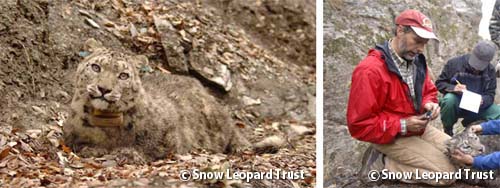Snow leopard project involving fitting GPS collars using the Argos satellite system, Pakistan

In November 2006, Dr. Tom McCarthy (Conservation Director of the Snow Leopard Trust), and the Wildlife Department of Pakistan, initiated a project in Chitral Gol National Park (CGNP), located in northern Pakistan near Chitral, high in the Hindu-Kush, and it will continue for 3 years. Their goal was to trap up to five snow leopards without injuring them and fit them with GPS collars. So far they have trapped one snow leopard called Ms Bayed, a very charming and calm cat, in November 2007 and fitted her with a GPS collar. Heavy snow has now forced the team to wait until spring to capture more leopards.
According to Dr. McCarthy, even when snow leopards are in a snare they don't act aggressively towards him as he works to sedate them - they just try to avoid to him. In fact his favorite cat, Ms. Bayed, has been caught in snares three times and the team members have now closed the snares to avoid injuring her. The team tracks her twice a month using a VHF signal on the ground, and they meet with Ms. Bayed somewhere in the mountains to learn more about her.
We are able to access the details of such an amazing and ongoing story on the following Web site.
http://news.bbc.co.uk/2/hi/technology/6159767.stm
The collar takes GPS readings three times a day, and once every two weeks the data is sent via the Argos satellite system to the researchers. The positional data is ideally suited for the study and will allow:
detailed home range analysis
identification of precise movement corridors
micro-habitat analysis when used in combination with GIS
This project will collect critical data on snow leopard home-range size, movement and activity patterns, use of travel corridors, intra-specific distances (avoidance of conspecifics), and human-snow leopard interactions (snow leopard habitat use in relation to human habitation and livestock pastures). This will allow implementation of appropriate conservation strategies based on improved understanding of snow leopard habitat requirements and ecology. Conservation within Pakistan and across snow leopard territory will be benefited by recommendations for new or expanded protected areas.
The Snow Leopard Trust:
www.snowleopard.org